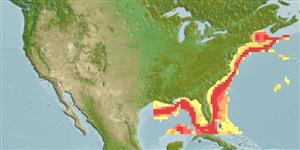Malacostraca |
Decapoda |
Geryonidae
Environment: milieu / climate zone / depth range / distribution range
Ecology
Benthic; depth range 0 - 2243 m (Ref. 104446). Temperate, preferred 22°C (Ref. 107945); 44°N - 23°N, 94°W - 62°W
Western Atlantic: From Emerald Bank, Nova Scotia, Canada, and the Gulf of Maine to the Mid-Atlantic Bight and the Gulf of Mexico.
Length at first maturity / Size / Weight / Age
Maturity: Lm ?, range 7 - 9.1 cm Max length : 18.0 cm CW male/unsexed; (Ref. 96186); 13.6 cm CW (female)
The larvae of this species may remain planktonic for up to 4 months before settlement depending on water temperature (Ref. 2763). Found along the continental shelf edge and slope. Associated with smooth or dimpled, unconsolidated and consolidated silt-clay sediments. Also occurs in canyon community (Ref. 96189). Displays deep-to-shallow migration as crabs mature wherein adult females generally inhabit shallower water than adult males, while juveniles tend to occur in deeper waters than adults (Ref. 96186). Reported to be opportunistic feeders. Adults eat benthic fauna such as sponges, hydroids, gastropods, scaphopods, small polychaetes and crustaceans, as well as larger prey like demersal and mid-water fish, squid and quill worm. Also scavenges deadfalls of fish and squid. May at times resort to deposit feeding and consume man-made artifacts (Ref. 96189).
Adult females do not mate every year. After mating, females carry fertilized eggs on their pleopods for up to 9 months until the larvae are released (Ref. 2765). Brood sizes range from 160,000 to 270,000 eggs, and fecundity increases with female body size (Ref. 2766).
Abellán, L.J.L., E. Balguerías and V. Fernández-Vergaz 2002 Life history characteristics of the deep-sea crab Chaceon affinis population off Tenerife (Canary Islands). Fish. Res. 58(2):231-239. (Ref. 2677)
IUCN Red List Status
(Ref. 130435: Version 2025-1)
CITES status (Ref. 108899)
Not Evaluated
Not Evaluated
Threat to humans
Human uses
Fisheries: commercial
FAO - Fisheries: landings | FishSource | Sea Around Us
Tools
More information
Human RelatedStamps, coins, misc.
Internet sources
Estimates based on models
Preferred temperature
(Ref.
115969): 3.8 - 12.9, mean 6.4 (based on 34 cells).
Fishing Vulnerability
Low vulnerability (10 of 100).
Climate Vulnerability
Low to moderate vulnerability (30 of 100).
Nutrients : Calcium = 109 [35, 184] mg/100g; Iron = 1.59 [1.21, 1.97] mg/100g; Protein = 20.2 [19.2, 21.3] %; Omega3 = 0.285 [0.185, 0.386] g/100g; Selenium = 48.3 [-31.7, 128.3] μg/100g; VitaminA = 0 μg/100g; Zinc = 1.79 [1.17, 2.40] mg/100g (wet weight); based on
nutrient studies.
